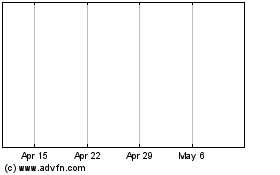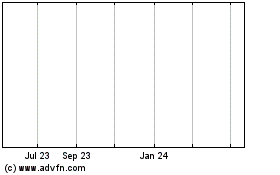Copper has a unique ability to gauge global economic trends and
the metal's climb to a more than two-year high speaks volumes about
the prospects for the world's emerging markets.
Copper's economic sensitivity is so great, in fact, that traders
often refer to it as "Dr. Copper," suggesting that it holds a Ph.D.
in economics because of its ability to help predict economic
trends.
"Copper is not easily replaceable so often end users cannot
substitute" for it as they can for other base metals, said Kevin
Kerr, editor of Kerr Commodities Watch. "That is one of the
elements that makes copper such a good gauge of real value in the
industrial metals."
And right now, Dr. Copper's value gauge is rising off the
charts.
Futures prices for the metal climbed to a 26-month high in New
York this week, with many investors convinced that demand for the
industrial metal will continue to climb from countries such as
China and India.
"The fact that the price of copper is strong means that
investors are becoming confident that the Great Recession is a past
story," said Sam Subramanian, editor of AlphaProfit Sector
Investors' Newsletter. "Backed by economic growth, particularly in
emerging markets, demand for copper should remain strong."
Copper consumption in China, the world's biggest consumer of the
metal, may climb 14% this year, CRU International Ltd. said in
April, according to a report in the China Daily. Consumption
reached 5.94 million metric tons in 2009, the report said.
In India, copper consumption's forecast to climb 15% to total
650,000 metric tons by the end of the current calendar year, credit
rating agency Icra said, according to a September report in the
Business Standard.
The expected increase in copper consumption may sound a bit
ambitious when compared to the Asian Development Bank's forecasts
for Indian gross domestic product growth of 8.5% in the fiscal year
to March 2011 and estimate of 9.6% GDP growth in China for this
year.
Still, "the long-term prognosis that Dr. Copper is sending us is
that we will see continued growth and recovery and therefore more
pent-up demand for copper and other base and industrial metals,"
said Kerr.
As with any commodity, demand is a key factor for copper--and
most of that has been coming from emerging markets.
Europe, Japan and the U.S. make up about 30% of global copper
demand, while around 35% comes from China, said Cary Pinkowski,
chairman of CP Capital Group. So "if there is a prolonged slowdown
it does not matter. China's growth alone will absorb all new copper
production going forward."
But traders don't know how much of the copper China's buying is
actually being consumed. It's "conceivable" that China may be
building inventory, anticipating a shortage down the road," said
Subramanian.
Christopher Ecclestone, mining strategist at Hallgarten &
Company LLC, warned that "any global hiccup" will be China's
"excuse to dump some warehouse stocks on a bad trading day" and
blast copper prices back below $3.20 per pound. Copper futures
closed at $3.68 on Thursday.
"The bulls in copper are delusional to not think that the
Chinese 'market-make' this commodity," Ecclestone said. "It's the
easiest (with zinc) for them to throw their weight around--and now
they have big inventories to do it with."
Given that, he believes copper has gone nearly as far as it can
go.
William Gamble, president of Emerging Market Strategies, seemed
convinced of that as well.
"Any demand for commodities will be affected by any break in the
demand from the emerging markets, which is the only real source of
demand at present," he said, emphasizing that in China, a "break"
means a slowdown, not a collapse.
And for China, the general assumption is that the nation will
continue to grow and thereby support demand for commodities, Gamble
said: "But what if that assumption is incorrect?"
Emerging-market economies, including India, Indonesia, Malaysia,
Peru and Chile, remain strong. "This is a bubble fueled by free
money coming out of central banks," Gamble said. "In these
countries, a break will have far more immediate consequences."
Even so, Subramanian thinks that "Dr. Copper is saying emerging
markets should continue growing at a good clip for at least another
3 months."
And for those willing to bet on a bright future for copper,
there are exchange-traded funds and many copper producers to choose
from.
Scott Wright, an analyst at financial-services company Zeal LLC,
said his favorite major copper stocks include Freeport-McMoRan
Copper & Gold Inc. (FCX), which is also a big gold producer,
and Southern Copper Corp. (SCCO). He also sees opportunity in some
smaller copper companies such as Augusta Resource Corp. (AZC,
ABE1.XE) and Taseko Mines Ltd. (TGB, TKO.T).
"The copper stocks should outperform," especially in a rising
S&P 500 (SPX) environment, he said. Wright has positions in the
stocks he mentioned.
Among the ETFs, there are Global X Copper Miners (COPX) and
First Trust ISE Global Copper Index Fund (CU), said Subramanian,
and to participate in the price movement of the metal itself,
there's iPath Dow Jones-UBS Copper ETN (JJC), which tracks the
price of copper futures on the Comex division of the New York
Mercantile Exchange.
(Myra P. Saefong writes for MarketWatch. She can be reached at
415-439-6400 or by email at AskNewswires@dowjones.com)
Augusta Resource Corp. Ordinary Shares (Canada) (AMEX:AZC)
Historical Stock Chart
From Mar 2024 to Apr 2024

Augusta Resource Corp. Ordinary Shares (Canada) (AMEX:AZC)
Historical Stock Chart
From Apr 2023 to Apr 2024
